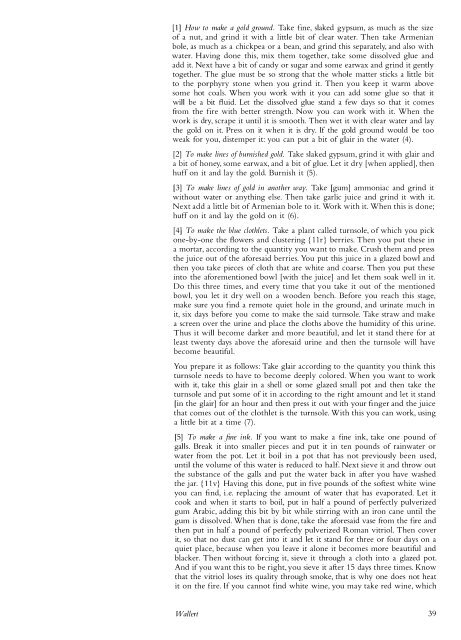Historical Painting Techniques, Materials, and Studio Practice
Create successful ePaper yourself
Turn your PDF publications into a flip-book with our unique Google optimized e-Paper software.
[1] How to make a gold ground. Take fine, slaked gypsum, as much as the size<br />
of a nut, <strong>and</strong> grind it with a little bit of clear water. Then take Armenian<br />
bole, as much as a chickpea or a bean, <strong>and</strong> grind this separately, <strong>and</strong> also with<br />
water. Having done this, mix them together, take some dissolved glue <strong>and</strong><br />
add it. Next have a bit of c<strong>and</strong>y or sugar <strong>and</strong> some earwax <strong>and</strong> grind it gently<br />
together. The glue must be so strong that the whole matter sticks a little bit<br />
to the porphyry stone when you grind it. Then you keep it warm above<br />
some hot coals. When you work with it you can add some glue so that it<br />
will be a bit fluid. Let the dissolved glue st<strong>and</strong> a few days so that it comes<br />
from the fire with better strength. Now you can work with it. When the<br />
work is dry, scrape it until it is smooth. Then wet it with clear water <strong>and</strong> lay<br />
the gold on it. Press on it when it is dry. If the gold ground would be too<br />
weak for you, distemper it: you can put a bit of glair in the water (4).<br />
[2] To make lines of burnished gold. Take slaked gypsum, grind it with glair <strong>and</strong><br />
a bit of honey, some earwax, <strong>and</strong> a bit of glue. Let it dry [when applied], then<br />
huff on it <strong>and</strong> lay the gold. Burnish it (5).<br />
[3] To make lines of gold in another way. Take [gum] ammoniac <strong>and</strong> grind it<br />
without water or anything else. Then take garlic juice <strong>and</strong> grind it with it.<br />
Next add a little bit of Armenian bole to it. Work with it. When this is done;<br />
huff on it <strong>and</strong> lay the gold on it (6).<br />
[4] To make the blue clothlets. Take a plant called turnsole, of which you pick<br />
one-by-one the flowers <strong>and</strong> clustering {llr} berries. Then you put these in<br />
a mortar, according to the quantity you want to make. Crush them <strong>and</strong> press<br />
the juice out of the aforesaid berries. You put this juice in a glazed bowl <strong>and</strong><br />
then you take pieces of cloth that are white <strong>and</strong> coarse. Then you put these<br />
into the aforementioned bowl [with the juice] <strong>and</strong> let them soak well in it.<br />
Do this three times, <strong>and</strong> every time that you take it out of the mentioned<br />
bowl, you let it dry well on a wooden bench. Before you reach this stage,<br />
make sure you find a remote quiet hole in the ground, <strong>and</strong> urinate much in<br />
it, six days before you come to make the said turnsole. Take straw <strong>and</strong> make<br />
a screen over the urine <strong>and</strong> place the cloths above the humidity of this urine.<br />
Thus it will become darker <strong>and</strong> more beautiful, <strong>and</strong> let it st<strong>and</strong> there for at<br />
least twenty days above the aforesaid urine <strong>and</strong> then the turnsole will have<br />
become beautiful.<br />
You prepare it as follows: Take glair according to the quantity you think this<br />
turnsole needs to have to become deeply colored. When you want to work<br />
with it, take this glair in a shell or some glazed small pot <strong>and</strong> then take the<br />
turns ole <strong>and</strong> put some of it in according to the right amount <strong>and</strong> let it st<strong>and</strong><br />
[in the glair] for an hour <strong>and</strong> then press it out with your finger <strong>and</strong> the juice<br />
that comes out of the clothlet is the turnsole. With this you can work, using<br />
a little bit at a time (7).<br />
[5] To make a fine ink. If you want to make a fine ink, take one pound of<br />
galls. Break it into smaller pieces <strong>and</strong> put it in ten pounds of rainwater or<br />
water from the pot. Let it boil in a pot that has not previously been used,<br />
until the volume of this water is reduced to half. Next sieve it <strong>and</strong> throw out<br />
the substance of the galls <strong>and</strong> put the water back in after you have washed<br />
the jar. {11 v} Having this done, put in five pounds of the softest white wine<br />
you can find, i.e. replacing the amount of water that has evaporated. Let it<br />
cook <strong>and</strong> when it starts to boil, put in half a pound of perfectly pulverized<br />
gum Arabic, adding this bit by bit while stirring with an iron cane until the<br />
gum is dissolved. When that is done, take the aforesaid vase from the fire <strong>and</strong><br />
then put in half a pound of perfectly pulverized Roman vitriol. Then cover<br />
it, so that no dust can get into it <strong>and</strong> let it st<strong>and</strong> for three or fo ur days on a<br />
quiet place, because when you leave it alone it becomes more beautiful <strong>and</strong><br />
blacker. Then without forcing it, sieve it through a cloth into a glazed pot.<br />
And if you want this to be right, you sieve it after 15 days three times. Know<br />
that the vitriol loses its quality through smoke, that is why one does not heat<br />
it on the fire. If you cannot find white wine, you may take red wine, which<br />
Wallert 39


